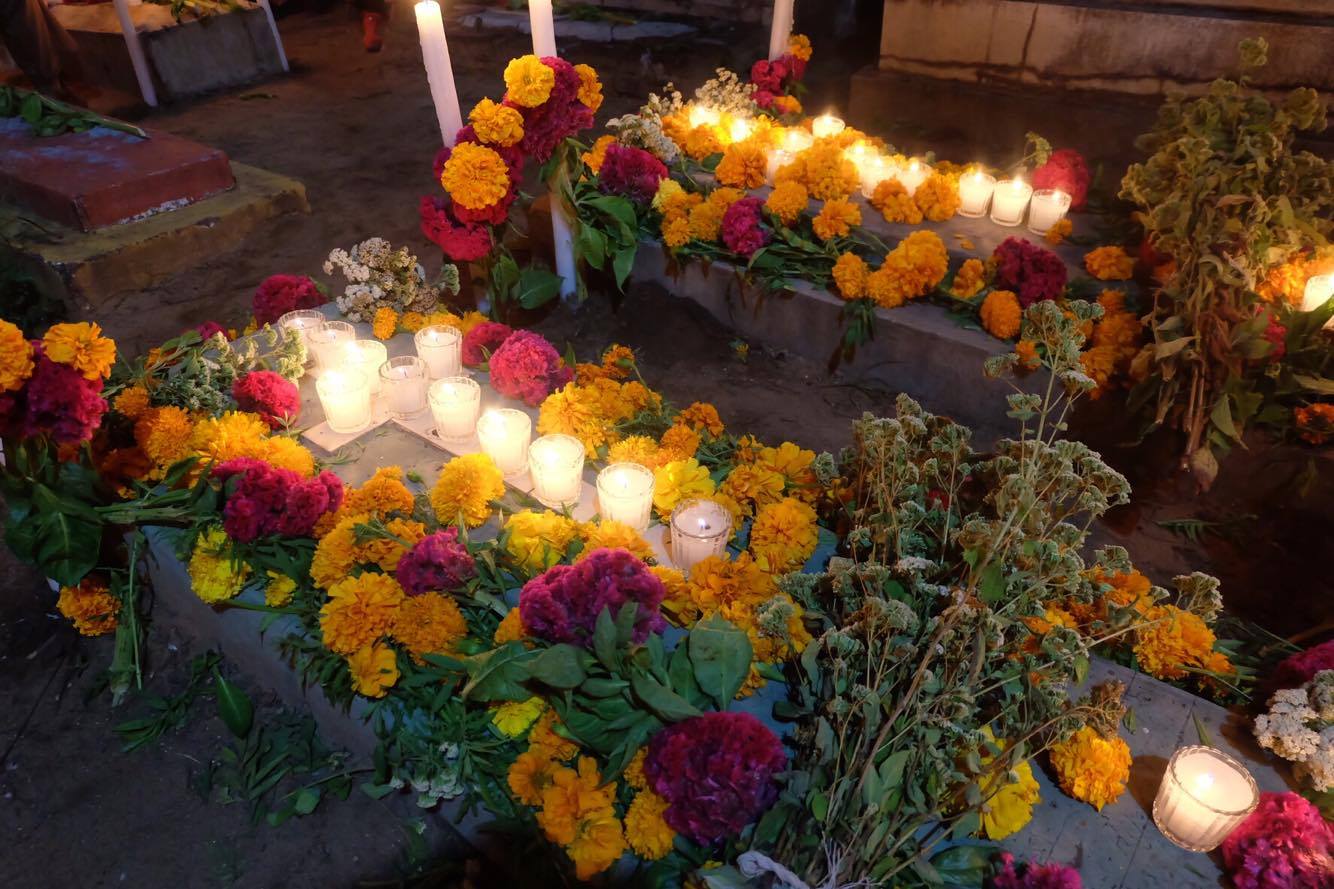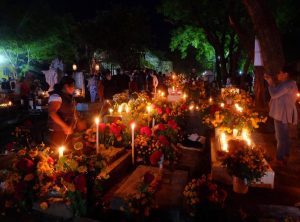
Honouring the dead and welcoming spirits at the Panteon (cemetary)
Día de muertos
Dia de Muertos es una celebración mexicana que se celebra los días 1 y 2 de noviembre cada año. A pesar de todas las calaveras, no es Halloween, y no es fantasmal. De hecho, es una tradición en que las familias honran las almas de sus queridos muertos, porque hay una creencia que dice el umbral entre la vida y la muerte esta lo más transparente, así que los espíritus pueden cruzarlo para visitar sus familias. La gente prepara ofrendas y altares de flores (cempasúchil), velas, comida y bebida favorita para dar la bienvenida a sus queridos. Las festividades ocurren en el hogar o en panteones, donde la gente come, bebe y celebra con música toda la noche para recibir los que ya no están viviendo.
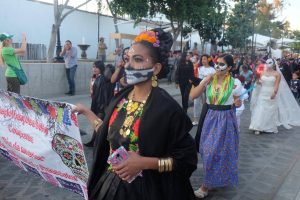
Mi experiencia de Día de muertos
El 1 y 2 de noviembre son días inhábiles en México, así que yo aproveché del tiempo para viajar a una región bien conocida para sus festividades de Día de muertos: Oaxaca. Llegamos por la noche del 31 de octubre y buscamos inmediatamente un desfile de la calle con la gente en disfraces y música en vida. Esta noche fuimos a un panteón en que había tumbas adornadas increíblemente con flores y velas, y había muchas familias pasando tiempo allá para estar con las almas de sus queridos. Yo tenía cuidado para estar respetuosa, evitaba a tomar fotos de familias en este tiempo, pero honoraba los muertos. Los dos panteones que visitamos estaban casi dorados con la luz de las velas y cempasúchiles. Fue una noche hermosa. El día siguiente, pasábamos el tiempo explorando la ciudad y sus mercados, vimos muchas ofrendas en casas y edificios, y absorbimos la energía de todo. Por la noche, mucha gente, incluyendo nosotros, disfrazaba como La Catrina u otros esqueletos, y ¡la fiesta empezó! La gente local bailó en desfiles por la calle, y la banda tocaba toda la noche.
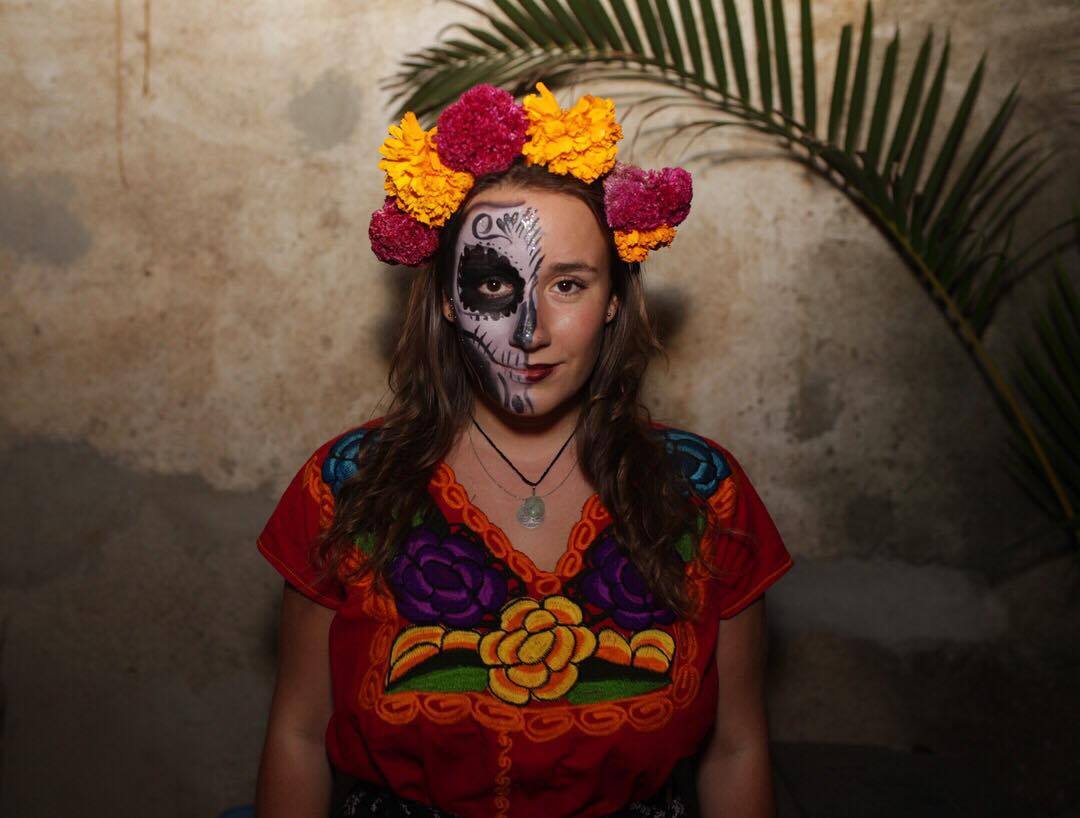
Orígenes
La celebración tiene sus raíces en los tiempos prehispánicos, cuando se dedicaba un mes total a la diosa Mictlantecuhtli. Durante la conquista del siglo 16, la celebración se combinaba con la festividad católica de Día de todos los santos – una tradición que también honran los muertos.
Creencias y ofrendas
El 1 de noviembre se llama Día de los Angelitos, esto es el día cuando las almas de niños visitan, y el 2 de noviembre es para las almas adultas. Flores y velas sirvan para guiar los espíritus a la ofrenda: el olor fuerte de los cempasúchiles, y la luz de las velas. Las familias asientan por la tumba y recontar memorias, a menudo tienen una cena pequeña para comer con los espíritus. Además, una costumbre es invitar otra gente a dentro de tu casa, porque esta creído que cualquiera persona puede venir con el alma de un querido. Ofrendas están bien linda adornadas, con papel picados colorados, fotos, flores, velas, calaveras de azúcar, comida y bebida. La comida típica consiste de pan de muerto (un pan dulce con el diseño de huesos y calaveras arriba), Calaveras de azúcar, dulce de calabaza, y tamales. Hay que recordar las bebidas – mezcal, pulque y atole.
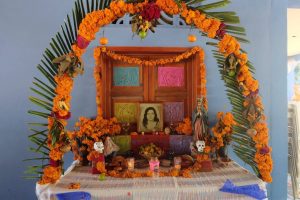
La calavera Catrina
Un elemento común de Día de muertos es la figura de la calavera Catrina. Calaveras son comunes como mascaras o pintura en la cara, pero Catrina es la calaca mujer hermosa creado por José Guadalupe Posada – una figura que hoy día es sinónimo con Día de muertos.
Para pasar un Día de Muertos ‘verdadero’ en México fue increíble, y ¡disfruté mucho disfrazarme como la Catrina! Pero la parte la más emocionante para mí fue la oportunidad a ver los panteones llena de familias honrando los muertos – un contraste enorme a las connotaciones oscuras y fantasmales con que estamos acostumbrados a asociarlos. Me parecía más como una celebración de la vida de estas almas queridas, que una celebración de la muerte, y yo estaba orgullosa a verla.
[ENGLISH]
Day of the dead, November 2017
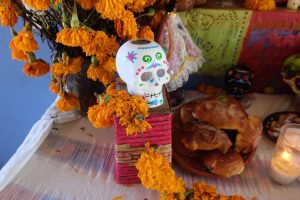 Day of the dead is a Mexican celebration which takes place between October 31 and November 2 each year. Despite the skulls, it is not Halloween, and it is not spooky. In fact, it is when families honour the spirits of their dead loved ones, as it is believed the threshold between the living and the dead is at it’s thinnest and therefore the spirits are able to come back to visit their family. Families prepare ofrendas (offerings) of flowers, candles, favourite foods and drinks to welcome back their loved ones. The festivities take place in the home or in cemeteries, where people eat, drink and play music all night to celebrate those who are no longer on earth.
Day of the dead is a Mexican celebration which takes place between October 31 and November 2 each year. Despite the skulls, it is not Halloween, and it is not spooky. In fact, it is when families honour the spirits of their dead loved ones, as it is believed the threshold between the living and the dead is at it’s thinnest and therefore the spirits are able to come back to visit their family. Families prepare ofrendas (offerings) of flowers, candles, favourite foods and drinks to welcome back their loved ones. The festivities take place in the home or in cemeteries, where people eat, drink and play music all night to celebrate those who are no longer on earth.
My experience of Day of the Dead
November 1st and 2nd are public holidays in Mexico so I made the most of this time to travel to a region which is renowned for the best Day of the dead celebrations: Oaxaca (English pronunciation: ‘wahaca’). We arrived on the night of 31st and immediately were greeted with parades in the streets with people dressed up and bands playing. We went to visit a cemetery on this night where we saw wonderfully ornately decorated gravestones with lots of families spending time with the spirits of their loved ones. I was careful to be very respectful and not take photos of them at these times, but honour the dead as they were also doing. The two cemeteries we visited were lit up with candles and the hundreds of red and yellow flowers. It was a beautiful evening. The following day, we spent the day exploring the city and markets, seeing many ofrendas in different houses and taking in the energy of it all. By night, people (including us) dressed up as La Catrina or other skeletons, and the party celebration began! The local people led parades in the streets, dancing for hours and hours on end and the brass band kept up!
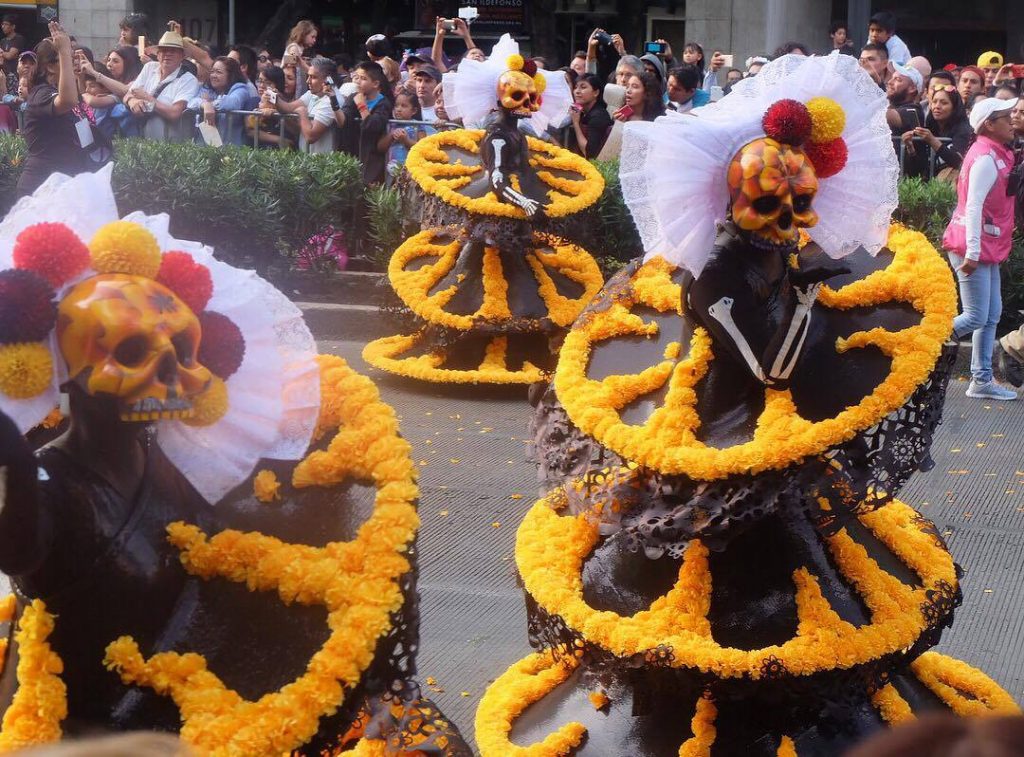
History
The celebration has been traced back thousands of years to the Aztec times, when it was dedicated to ‘the lady of the dead’, but during the conquest of the 16th century the celebrations were merged with catholic traditions of All saint’s day and All Souls day – celebrations which also honour the dead.
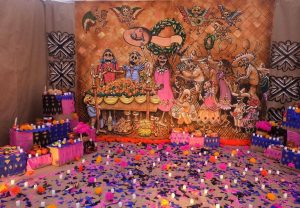 Beliefs and Ofrendas
Beliefs and Ofrendas
It is believed that November 1st is Dia de Angelitos, the day when child spirits come to visit, and November 2nd is when adult souls visit. Flowers and candles are used to guide the spirits to the altar: the strong scent of marigolds and the light from the candles. The family will sit around the graves and tell stories and memories, often having a picnic to sit and eat with the spirits. It is also customary to invite people into your house during this time and offer them food, as it is believed that anyone could bring with them the spirit of your loved ones. Ofrendas are decorated beautifully, with colourful paper cut-outs, photos, flowers, candles, sugar skulls, food and drink. Typical food consists of pan de muerto (literally ‘dead bread’ but it is a sweet bread which has the pattern of bones and skulls on top), Calaveras (sugar skulls), sweet pumpkin and tamales are also eaten. Not to forget the drinks – Mezcal, Pulque, and Atole.
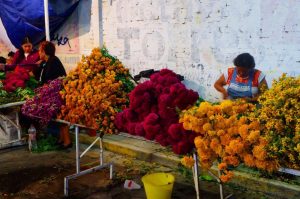 La calavera Catrina
La calavera Catrina
A popular part of modern Day of the Dead, is the figure of la calavera Catrina. Calaveras (skulls) are common as masks or face paint, but Catrina is the beautiful lady skeleton created by José Guadelupe Posada which has become synonymous with Día de Muertos.
It was amazing to experience the ‘real’ day of the dead in Mexico, and of course I loved dressing up as La Catrina! But the most moving part for me was seeing the cemeteries alive with families honouring the dead – a huge contrast to the dark, spooky connotations we normally associate them with. It felt more like a celebration of the life of these loved souls than of death, and I was proud to witness it.
